
Making generalizations about the visual culture of any group of people is a crude endeavor, especially with a culture as diverse as Mexico's. With this thought in mind, know that this survey, as any must be, is tremendously limited in its breadth and depth.
[Expect a more in-depth article to appear here soon.]
Examples:
Bienvenido - Esta página esta bajo construción. Por favor visítenos próximamente.

Mexico, Puebla State, Olmec peoples, "Baby" Figure, 12th-9th century
BCE,
ceramic, pigment, height 13 3/8 inches (34 cm),
Metropolitan Museum of Art, NY. See Pre-Columbian
art.

Olmec culture (Mexico, Tabasco(?), Middle Preclassic period, about 900-300 BCE), Transformation Figure, serpentine with traces of cinnabar, height 4 1/4 inches (10.8 cm), Los Angeles County Museum of Art. This figure is apparently part man and part jaguar.

Mexico, Jalisco, El Arenal Brown style, Late
Preclassic - Early Classic period, about 100 BCE
- 300 CE,
Standing Warrior (The "King"),
ceramic with red slip,
yellow, white, and black paint,
37 x 15 inches (94 x 38.1 cm), Los Angeles County Museum of Art.
See Mesoamerican art and Pre-Columbian.
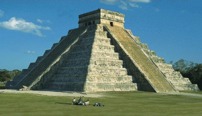
Mexico, Yucatan Peninsula, Maya peoples,
El
Castillo, pyramid at Chichen Itza, c. 9th century. See
pyramid.

Juan Baptiste Cuiris (Mexico, Michoacán,
Pátzcuaro), Feather Picture of the Virgin Mary, c.
1550/80, hummingbird and parrot feathers
on paper, wood; signed,
25.4 x 24.3 cm, Kunsthistoriches Museum, Vienna. See iridescence
and luminosity.
José María Velasco (Mexican, 1840-1912), The Hacienda of Chimilpa, 1893, oil on canvas, 104 x 159 cm, Museo Nacional de Arte, Mexico City.
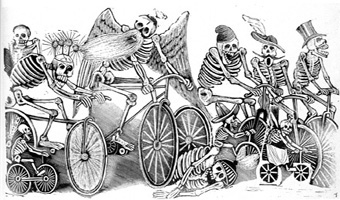
Jose Guadalupe Posada (Mexican, 1852-1913),
Calavera depicting contemporary newspapers as
skeleton cyclists, c. 1889-1895, broadside,
engraving on
type metal.
Jose Guadalupe Posada, Calavera of Don Quijote, no date, broadside, engraving on type metal.
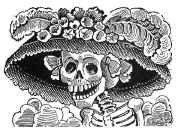
Jose Guadalupe Posada, The calavera of the fashionable lady (La calavera
catrina), 1913, broadside,
relief etching on zinc.
Jose Guadalupe Posada (Mexican, 1852-1913), Happy dance and wild party of all the skeletons (Gran fandango y francachela de todas las calaveras), no date, broadside, engraving on type metal. See dance.
José Clemente Orozco (Mexican, 1883-1949), Three Generations, 1926, lithograph, image 27.3 x 37.3 cm; sheet 40.3 x 57.5 cm, Fine Arts Museums of San Francisco, CA.

José Clemente Orozco, The Epic of American Civilization, Modern Migration of the Spirit (Panel 21), between
1932 and 1934, mural painting, reserve
corridor of Baker Library, Hood Museum of Art, Dartmouth U. In its entirety, the mural covers
approximately 3,200 square feet.
One of
the twenty-four panels, or "scenes" of which the mural
is composed. Its subject
is the Americas from the migration of the Aztecs into central
Mexico to the development of our modern industrialized society. More about the mural and preliminary drawings.

Diego Rivera (Mexican, 1886-1957), Still
Life with Bottle, 1914, drawing with pencil,
papier-collé and
gouache on paper, 35.5 x 19 cm, government of
Veracruz, Mexico. Among the papers Rivera used is some wallpaper.
Diego Rivera, Revolt and The New Religion, 1929-1930, 13 feet 11 inches x 4 feet 5 inches and 14 feet 3 inches x 4 feet 3 inches, fresco, Cortes Palace, Cuernavaca, Mexico. See mural.

Diego Rivera, Niño con Taco, 1932, lithograph, Library of Congress, Washington,
DC.

David Alfaro Siqueiros, La Colina de los Muertos, 1944, Duco
on board, 37 1/4 x 27 inches (94.8 x 68.5 cm), Santa Barbara
Museum of Art, CA.
Rufino Tamayo (Mexican, 1899-1991), Portrait of Rosalind Richards, 1948, oil, charcoal, and pastel on gessoed masonite, Hood Museum of Art, Dartmouth U.
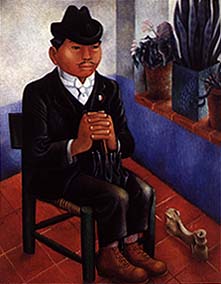
Miguel Covarrubias (Mexican,
1904-1957, worked in the USA), The Bone, oil on canvas, 75.3 X 59.6 cm. See caricature.
Frida Kahlo (Mexican, 1907-1954), Self-Portrait Between the Borderline of Mexico and the United States, 1932, oil on tin, 11 3/4 x 13 1/2 inches, collection of Mr. and Mrs. Manuel Reyero.

Frida Kahlo, My Grandparents,
My Parents, and I (Family Tree), 1936, oil
and tempera on metal
panel, 12 1/8 x 13 5/8 inches (30.7
x 34.5 cm), Museum of Modern Art, NY. See feminism
and feminist art and self-portrait.

Frida Kahlo, Self-Portrait Dedicated to Leon Trotsky,
1937, oil on board, 30
x 24 inches, National Museum of Women in the Arts, Washington,
DC.
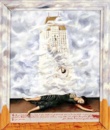
Frida Kahlo, El suicido de Dorothy Hale (The Suicide of Dorothy Hale), 1939, oil on Masonite panel with painted frame, Phoenix Art Museum, AZ. The subject is Dorothy Hale, a society woman who became despondent and threw herself from the window of her New York apartment. Kahlo describes the horrible event in the inscription, which is written in Spanish. The English translation is:
"In New York City on the 21st of October 1938, at 6:00 in the morning, Dorothy Hale committed suicide by throwing herself from a very high window in the Hampshire House. In her memory [...], this retablo was executed by Frida Kahlo." Part of the third line has been erased. Another part of the painting also was changed: an angel once appeared at the top. These erasures were made in response to the violent reaction from Clare Boothe Luce, who commissioned the work. See memorial and retablo.

Frida Kahlo, Self-Portrait with Cropped Hair, 1940,
oil on canvas,
15 3/4 x 11 inches (40 x 27.9 cm), Museum of Modern Art, NY.
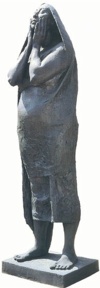
Francisco Zúñiga (Mexican,
1912-1998, born Costa Rica), Woman standing with Her Hands on Her Face, bronze,
205.5 x 56 x 46 cm, Zúñiga Foundation Collection.

Gunther Gerzso (Mexican, 1915-), Dos Personajes, 1956, oil
on canvas, 36 x 26 1/2
inches, Santa Barbara Museum of Art, CA.

Jesse Trevino (American, born Mexico, 1946-),
Mis Hermanos, 1976, painting, National
Museum of American Art, Washington, D.C. See Mexican
art.
![]()

Jesse Trevino, Tienda de Elizondo, 1993, painting, National
Museum of American Art, Washington, D.C.
Flor Garduño (Mexican, 1957-), Canasta de Luz, 1989, gelatin silver print, 9 x 6 3/4 inches.
Also see architecture, Baroque, Chicano art / Chicana art, costume, design, drawing, ethnic, expression, folk art, furniture, genre, landscape, lithography, Madonna, Mesoamerican art, milagro, mural, museum, mythology, narrative art, portrait, Pre-Columbian art, retablo, santero, santos, seascape, self-portrait, social realism, Spanish art, still life, textile, and watercolor, among many other articles.
https://inform.quest/_art